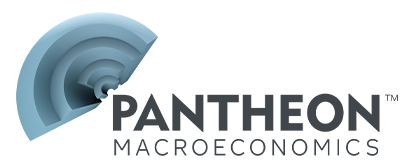US Publications
Below is a list of our US Publications for the last 6 months. If you are looking for reports older than 6 months please email info@pantheonmacro.com, or contact your account rep
Please use the filters on the right to search for a specific date or topic.
- October CPI and PPI data imply that the core PCE deflator increased by 0.30%, the most since March...
- ...But the rise was driven by volatile airline fares, a hot patch for the stock market and catch-up rent rises.
- The Boeing strike and hurricanes probably weighed down manufacturing output last month.
Samuel TombsUS
October's improvement mostly reflects politics.
Oliver Allen (Senior US Economist)US
- Over half of the 0.3% increase in the core CPI was due to rent, which Chair Powell has de-emphasized.
- CPI auto insurance prices likely will rebound in November, but airline fares prices probably will fall back.
- The jump in used auto prices is liable to reverse soon; core goods prices will continue to trend down.
Samuel TombsUS
- Core retail sales usually struggle after hurricanes, and warm weather likely weighed on clothing sales.
- Carryover from Q3 will support growth in consumption in Q4, but expect slower gains from here.
- Credit conditions remain very restrictive, as banks have continued to tighten lending standards.
Oliver Allen (Senior US Economist)US
- The core CPI likely rose by 0.3% in October, driven by used auto prices and hotel room rates.
- Underlying services inflation, however, probably continued to decline; rent inflation likely cooled too.
- November's CPI data should reassure the FOMC that it can ease policy again at next month's meeting.
Samuel TombsUS
Consumers in high spirits pre-election.
Oliver Allen (Senior US Economist)US
Weak October payrolls were only partly due to strikes and storms.
Oliver Allen (Senior US Economist)US
- Chair Powell emphasised that the elections would have little bearing on December's policy decision...
- ...Labor market data will support a further 25bp easing; more to come in 2025, but fiscal policy will be key.
- The Fed has little to fear from unit labor costs, even after the latest upward revisions.
Samuel TombsUS
Boosted partly by temporary supply chain disruption; core services inflation is still falling.
Samuel TombsUS
- Labor market data are weak enough for the FOMC to ease by another 25bp today...
- ...But tariffs likely will keep core PCE inflation above 2%, so we now look for more gradual easing in 2025.
- Much of Mr. Trump’s agenda, however, will depress GDP growth, keeping the terminal rate low.
Samuel TombsUS
- Donald Trump’s migration plans would hit growth in GDP and employment and likely push up inflation...
- ...But his campaign’s most extreme proposals for mass deportations seem unlikely to materialize.
- Ending election spending will depress consumption growth this winter, but leave jobs largely unaffected.
Samuel TombsUS
- We think that a 10pp jump in the effective tariff rate would boost the core PCE deflator by about 0.8pp.
- The experience of past tariffs suggests exporters will maintain prices and retailers absorb little of the cost.
- Inflation expectations are above target-consistent levels; the Fed can’t ignore the tariffs this time.
Samuel TombsUS
Weakness in the sector extends well beyond Boeing.
Oliver Allen (Senior US Economist)US
Subdued core PCE inflation and slowing ECI growth green light further material Fed easing.
ian shepherdson (Chief Economist, Chairman and Founder)US
Hit to payrolls from Milton likely was limited.
Oliver Allen (Senior US Economist)US
Probably not the start of a strong recovery.
Oliver Allen (Senior US Economist)US
Solid growth unlikely to prevent a November easing.
Oliver Allen (Senior US Economist)US
No reason to change payroll forecasts, given ADP's poor record
Oliver Allen (Senior US Economist)US
- The latest claims data suggest the hit to NFP from Hurricanes Helene and Milton was relatively small.
- September’s hefty rise in the core PCE deflator will be a blip; October’s storm-related boost will be small.
- Job market loosening points to lower core inflation in 2025, but Mr. Trump’s tariffs would upend that story.
Samuel TombsUS
